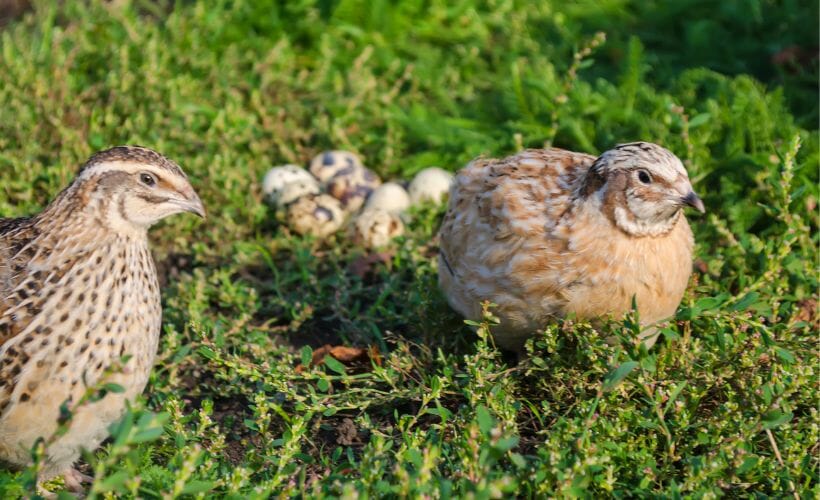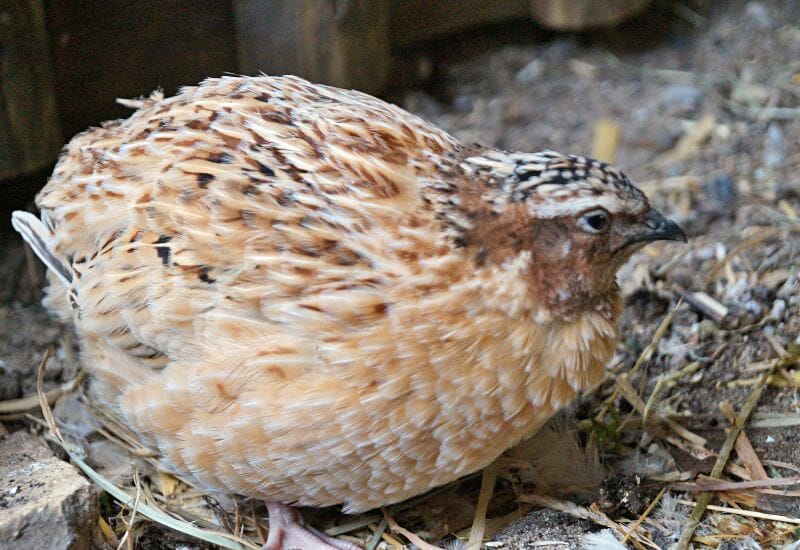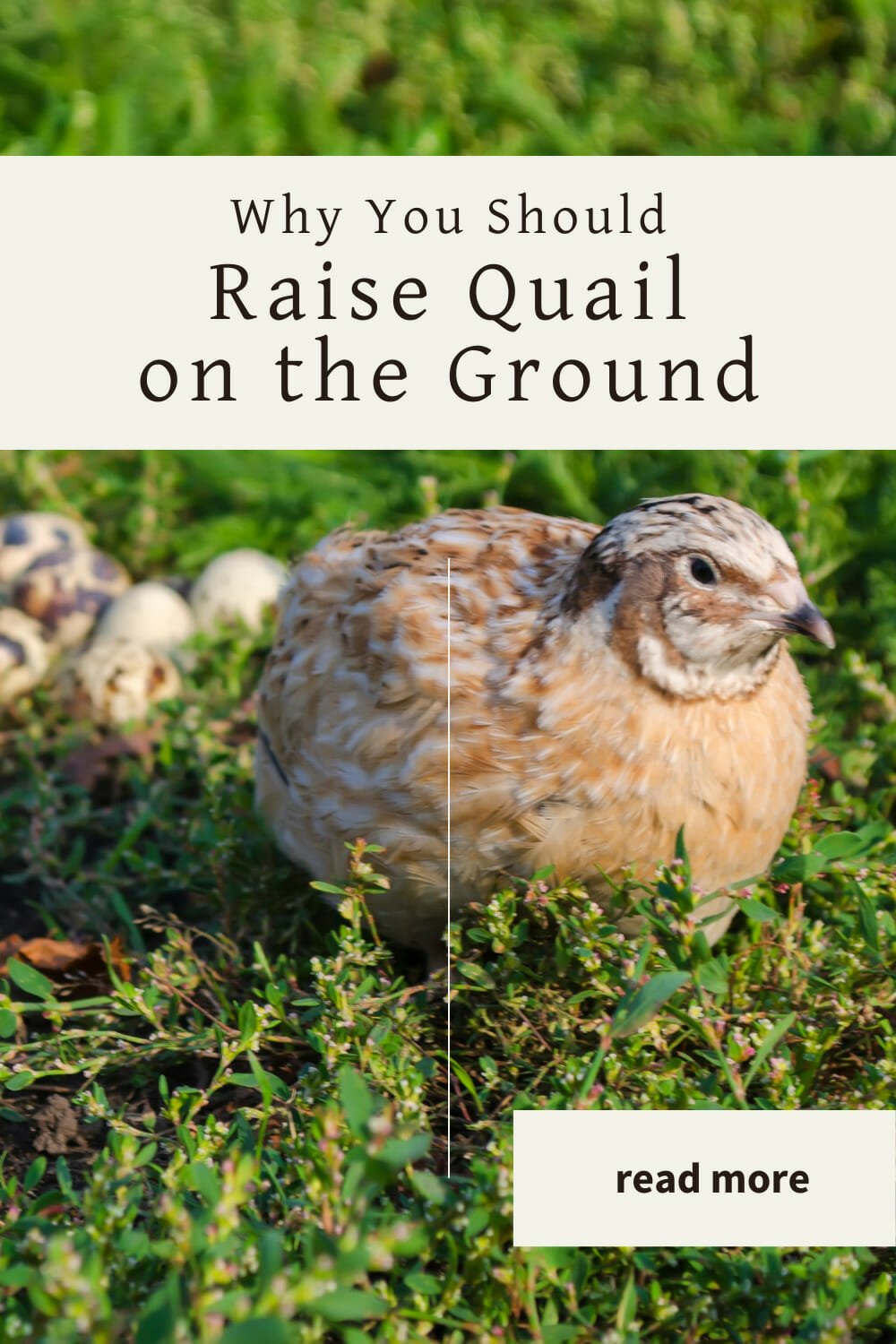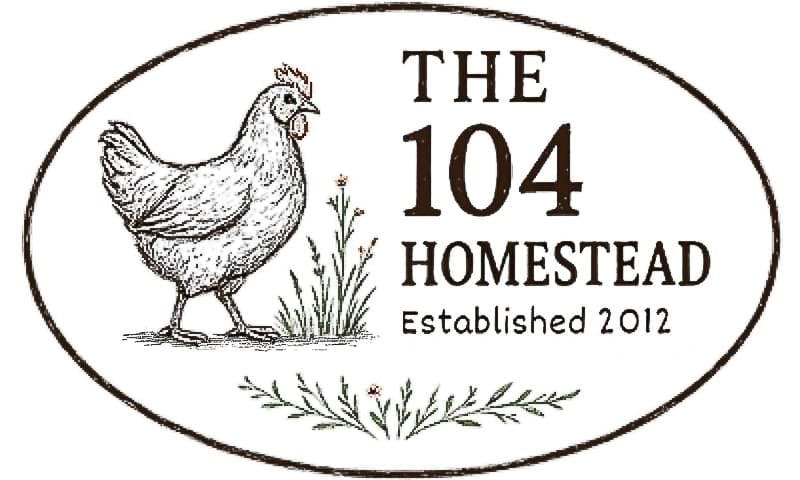Raising Quail on the Ground: The Best Outdoor Setups for Happy, Healthy Birds
Learn how to raise quail on the ground with simple outdoor setups that keep your birds healthy, safe, and easy to care for year-round.

When I started raising Jumbo Coturnix quail, I saw wire cages and stacked pens recommended everywhere. They do have their place. In fact, we still use them in our climate-controlled hatchery where space and cleanliness really matter.
If you’re still not sure whether quail fit your homestead, here’s why I think they’re one of the most overlooked birds you can raise.
But I also wanted to give some of our coveys something different: the chance to scratch through grass and hunt bugs. Free-ranging wasn’t realistic with hawks overhead and quail that can (and will) take off, but a secure pen with ground access felt like the perfect balance. Here’s what it really takes to raise quail in outdoor pens or aviaries: the pros and cons, space tips, predator protection, and which setups hold up long-term.
Why Raising Quail on the Ground Is Worth It
Raising Coturnix quail on the ground lets them actually act like birds. Coturnix quail are especially well-suited to ground setups thanks to their calm temperament and high egg production. They’re made for it. They can scratch, dust bathe, forage, and actually move in ways cages just don’t allow.
- Healthier, Happier Birds: Quail in ground setups get more stimulation and exercise. That keeps them healthier, cuts down on feather picking, and usually bumps up egg production.
- Built-in Clean-Up Crew: Quail droppings don’t pile up in the same way they do in cages. On the ground, they contribute to the soil, especially if you maintain a healthy living groundcover or rotate pens.
- Easier to Feed Naturally: If your pen includes greens, compost piles, or deep litter systems, your quail will supplement their feed with bugs and greens. That means healthier birds and lower feed bills.
- Less Day-to-Day Work: With a well-planned system, you may find outdoor setups need less daily maintenance than cages. More space means fewer refills, less cleanup, and a lot less micromanaging.
Best Setups for Ground-Raised Quail
You have a few good options when raising quail on the ground. Here are the three most common systems:
Quail Aviary
A quail aviary is just a big walk-in pen set right on the ground, enclosed with hardware cloth and covered on top for full protection. This is the closest you can get to free-ranging while still keeping your quail safe from predators and contained.
Aviaries let quail move naturally, forage for bugs, dust bathe, and explore without restriction. Ours are planted with low, chicken-safe greenery to encourage foraging and provide shade. We rotate these pens seasonally and mostly use them for our extra boys. It gives them space and something to do until processing time. It’s my favorite way to raise quail when space allows.
Stationary Coop + Run
This setup includes a fixed indoor coop (usually raised off the ground) connected to a secure, enclosed ground-level pen. It’s a solid choice if you already have a chicken coop and want to add quail without overhauling your whole setup.
We use this style for our layer hens. The indoor coop provides shelter, while the attached run gives them room to scratch, peck, and dust bathe. It’s easy to predator-proof and convenient for daily access and egg collection. If you’re keeping a small covey for eggs, this setup works really well.
Mobile Quail Tractor
A quail tractor is a lightweight, fully enclosed pen that can be moved around the yard. It gives your quail fresh access to new ground regularly, which helps prevent waste buildup and keeps their environment enriched with greens and bugs.
We’re just starting to incorporate tractors into our rotation. They’ve been great for keeping quail on pasture without wrecking the ground. They’re perfect for small yards or anyone who wants to let quail forage naturally without going all-in on a full aviary build. Just be sure to move them every few days so the ground doesn’t get too bare.

Designing a Safe, Low-Maintenance Outdoor Setup
A good outdoor setup keeps your quail safe and makes your life easier. Can’t beat that combo!
Space Requirements
You can technically fit 2–3 birds per square foot, but I always aim for about 1 square foot per adult in an outdoor setup. That extra room lets them do their bird thing.
Predator Protection
Use hardware cloth, never chicken wire. Bury an apron around the perimeter or add a solid floor under the soil layer to keep out diggers. Cover the top securely. Hawks, owls, and even neighborhood cats are a real threat.
Shelter & Shade
Give them a few spots to duck out of the wind or hide from bad weather. Small shelters, low tunnels, or even plants work great. My quail love terra cotta plant pots laid on their sides.
Forage, Dusting & Enrichment
Let them dig, scratch, and snack to their hearts’ content. Use dry dirt patches or old compost piles for dust baths, toss in weeds or bolted greens, and rotate the pen if possible.
Pros & Cons of Each Setup
Each setup (aviary, stationary coop with a run, or mobile tractor) has its own mix of perks and drawbacks. Your choice really depends on your space, goals, and how hands-on you want to be each day.
Aviary
- Pros: Natural behaviors, easy egg collection (if designed well), great for scaling up.
- Cons: More materials to build, harder to predator-proof, can be muddy if not maintained.
Stationary Coop + Run
- Pros: Familiar to chicken keepers, secure, weather protection.
- Cons: Limited space, needs frequent cleaning, egg hunting can be tricky.
Mobile Tractor
- Pros: Forage access, less cleaning, great for small yards.
- Cons: Needs frequent moving, limited space, harder in winter.
Raising Quail on the Ground: Common Questions
Still trying to decide if outdoor setups are right for your covey? Here are a few questions I get all the time and what’s worked for me.
Are you thinking of raising your quail on the ground? Pin it to your quail board!

Raising quail on the ground takes a bit more planning up front, but the payoff comes fast. Your birds will likely be healthier and more active, and once things are dialed in, your setup can actually be easier to maintain than cages. Whether you’re scaling up or just want to give your coveys a better setup, ground-based housing is worth considering as part of your overall quail system.
I dive deeper into aviaries, tractors, and other housing setups over on my sister site, Forget-Me-Not Quail Farm. If you’re just getting started with quail, my book 5 Mistakes New Quail Owners Make (And How to Avoid Them) is a great place to start.

How do you keep the sanctuary clean from poop? That’s the style I want to go with as well bc I can’t stand the thought of keeping mine in tiny cages.
Unless you have the pen overstocked, the quail keep it clean when they’re scratching up the soil.
This is what I want to do!! How do you manage the poop?
Our coop and run are positioned over the compost bin, so they’re pretty much self cleaning and the manure is used in the garden after it cools down.
Do you know if quail will bother garden plants?
We are raising jumbo coturnix and going to have them in a movable tractor for mow but we were thinking of making an qrea for them in the green house for when plants are small and the rest of the time when the plants are big or we don’t have plants let them have the whole greenhouse.. my husband is afraid they will eat everything… I was thinking they might not if they are kept away while the plants are young
I’d love to hear your thoughts
I plan on raising quail come late spring. My problem with quail on the ground is that I have bad knees, a bad ankle, and a sometimes floppy disk in my back. But I will see what I can do, at least part of the year. Or how I can best adopt your ideas to make both them and me happy.
You can only do what you can do. If keeping them on the ground doesn’t work for you, you can always do a raised coop and maybe add some fodder. https://104homestead.com/sprouted-barley-fodder/
Hello,
I was thinking about putting a removable “top” on one of my 4 by 10 raised garden beds and putting quail in and rotating between my two beds every year. Can you think of any reason that this would be problematic if there is a cover so they are dry and they have a “nesting” box?
Hi Carole,
I’ve just started raising quail. I read your blog about the plants you sowed in the coop. It’s very interesting. One thing I noticed with my quail is that they’re not so bothered about most veg, but they absolutely love “vegatable mallow” (Malva crispa). They will completely strip a branch in a day. You should try it and let me know if your quail enjoy it as much as mine 🙂
Hello Carol, We have a cage on the ground and move it around and the warn weather. I live Pa. and its getting cold and I worry about keeping them warm. We have put tarps on the top and on the side that the wind hits. They have a box they can get into,but I think it needs insulated. I really worry about the snow. What do you think about them being outside in winter on the ground?
I have an article from my blog you may find helpful for winterizing quail. Hay bales make great insulators around the exterior of the coop and I actually used shelter boxes inside their habitat – raised them off the ground using cut up landscaping timbers then filled the interior with hay as if making nest material. Because I had many quail with several of these shelters I also arranged them in a way that blocked out cold weather. Hope that helps – Carole
https://www.gardenupgreen.com/raising-quail-over-winter-and-snow/
IS it possible to get coturnix to regain there natural instincts? I know you have done it with the native breed but you said you start off with them. I am looking into pharoh d1 due to high egg production. also I am willing to put in a silkie to brood them if nessary. I was even thinking maybe quail raised by a chicken might teach them what they should do a little.? Where could I do more research. your the only source I can find only sorry this and your other blog. Also I do find comments here in there randomly but no hard how to stuff.
I started with the Coturnix on the ground and yes they will regain their natural instincts if you begin the process from the time they’re chicks. I have a large inventory of articles on my blog, Garden Up Green. This was a guest post I wrote for 104. I’ve always raised my quail on the ground from the beginning because it appeared very unnatural to me to raise birds on wire.
My Blog > https://www.gardenupgreen.com/
Quail Articles > https://www.gardenupgreen.com/category/quail
Do you have any issues with your quail getting worms due to being raised on the ground? My boyfriend and I have Texas a&m. His are in raised cages and mine are on the ground. He claims they can get roundworms if they are raised in the dirt, but they are infinitely happier when they are able to run around on the ground. What are your thoughts on this?
I did have one coturnix catch an eye worm parasite. IT was contracted from crickets consumption as they (Not all) can carry this parasite. I write about quail on my blog Garden Up Green where I share my experience.
I am thinking of raising quail for meat and eggs. I want them to be “free range” and would like to not give them feed. Did you need to feed them extra food or did they get enough from the grass and what ever bugs they could find.
Hello Heather, Free ranges is possible in a large closed in space, it can’t be open because the birds will fly away. To achieve your goal without feed you need to create a quail friendly environment with native grass and plants in addition to the bugs they will eat. To achieve this you will need a very large space and supplying enough food will depend on how many quail you raise. I always supplement my quail’s diet in addition to a natural environment. I’d like to invite you to my blog – Garden Up Green where I have many posts on the topic that would be helpful in your planning. -Carole
Hi Carol,
I saw in your bio that you’re in north Texas. I’m also in north Texas, in between Dallas and Ft Worth. I’m picking up my first dozen quail chicks this weekend! Do you often have chicks?
I’m currently in the middle of selling our farm in Greenville and relocating onto a 28 acres property. Congrats on the new bunch of Quail chicks how exciting! I don’t raise quail chicks to sell right now relocating is the focus right now but I do have many articles you’ll find helpful for raising quail chicks, my blog is Garden Up Green. I hope to get started with my Bobwhites again in June. Counting the day!! Hope to see you there! -Carole
Hello Carole, I like your ideas of keeping quail on the ground., I agree they are happiest on the ground and it is much gentler on their feet than wire.
But how do you protect them from rats? I have not met anyone who has succeeded terribly long keeping quail on the ground (unless there is a floor), as rats can eat them alive, and in our experience they can dig under a fence in a night. It would be great if you mention how you get around this, lest people try it, the results of this mistake are devastating to experience. Thank you!
Hey Vee -Here’s my question, how do quail survive in the wild from rats? I haven’t had any issues with rats in our sanctuary. It’s 60 ft long and the majority of their diet is free range. If rats are an issue for others it’s probably because they’re over feeding and rodents are seeking that feed. The other issue could be if the run is to small they have no place to escape from the rats. I also keep a clean farm with additional animals like, dogs, emus and chickens that help detour rodents. Keeping the grass low around the sanctuary is another smart thing as rodents and other pests like snakes hide in tall grass. I’d like to invite you to my blog, Garden Up Green where I have many posts on raising quail including different types of on the ground housing.
My wife and I are buying 20 acres of land in Virginia and want to raise ducks & quail for egg consumption ONLY. Also we would like to have a 40X20 greenhouse to grow our vegetable all year round. Can you direct me to or help me understand what we need to start learning so we can grow responsibly?
Hello, this is Carole from Garden Up Green, I wrote this article. I’ve got a book- Quail Getting Started that is for beginners interested in raising quail in a natural environment. You can find it on my blog along with many post about raising quail this way. I also have a new book coming out in February that I’m really excited about related to gardening. It’s a no fail natural gardening workbook, Startle Garden. Hope that helps. I’m sure you can also find helpful information here on Jessica’s blog. Congrats on the new acreage, we recently purchased 28 and we’re turning it into a tiny house community. SO excited!!